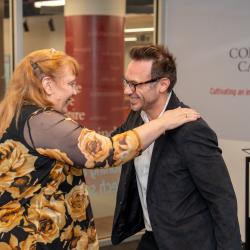Discovering a ‘Passion for Research’
Rivers that flow through the air, the differences between human and computer cognition and how neighborhoods affect substance abuse are some of the topics that will be on display Wednesday as students demonstrate their growing ability to formulate—and answer—deep questions with science and scholarship.
Roughly 500 students from disciplines across campus will present their work to peers, faculty and staff, and families and friends in the Stamp Student Union at Undergraduate Research Day. This showcase is a culmination of a valuable learning process that spans uncertainty, iteration, failure, problem-solving and unexpected outcomes, said Patrick Killion, director of the Office of Undergraduate Research.
“Undergraduate research has been shown to have really profound impacts on students personally and professionally,” said Killion, who also serves as director of the First-Year Innovation and Research Experience (FIRE). “Students grow in their confidence, in their self-efficacy, in their time management and communication skills, and in their resilience.”
Read on to meet some of the students from the College of Computer, Mathematical, and Natural Sciences who are involved.
Atrey Desai ’27
A computer science and linguistics double-degree student, Desai combined his fields of study in his research project, which came out of his work in Computer Science Assistant Professor Rachel Rudinger’s Computational Linguistics and Information Processing Lab. Desai identified shortcuts artificial intelligence might use to determine the correct answer to multiple choice questions. (One simple shortcut AI favors? The longest answer is probably the correct one.)
“I discovered that machines and artificial intelligence do not think in the same manner that humans do,” said Desai. “When a human is solving a math problem, we might think about another similar problem we’ve encountered and do a step-by-step process. AI is great at finding random clues that humans can’t really tell.”
Sofia Tellez-Fenner ’26

Atmospheric rivers, long bands of water vapor in the atmosphere that transport moisture and heat, are the focus of Tellez-Fenner’s research. The atmospheric and oceanic science major’s project examined how atmospheric rivers have affected the Arctic climate and gauged the accuracy of the current modeling system in representing these “rivers in the sky,” she said.
Participating in research has highlighted for Tellez-Fenner what her own strengths are. “I know I’m good at working behind the scenes and delegating tasks to people without being the typical, extroverted person up front,” she said.
Written by Sala Levin ’10 and Ruby Siefken ’26







